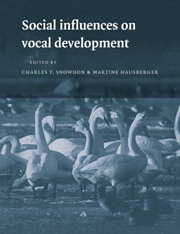Book contents
- Frontmatter
- Contents
- List of contributor
- 1 Introduction
- 2 Social interaction and sensitive phases for song learning: A critical review
- 3 Social interaction and vocal development in birds
- 4 Building a social agenda for the study of bird song
- 5 Field observations, experimental design, and the time and place of learning bird songs
- 6 Vocal learning in wild and domesticated zebra finches: Signature cues for kin recognition or epiphenomena?
- 7 What birds with complex social relationships can tell us about vocal learning: Vocal sharing in avian groups
- 8 Social influences on song acquisition and sharing in the European starling (Sturnus vulgaris)
- 9 Social influences on the acquisition of human-based codes in parrots and nonhuman primates
- 10 Vocal learning in captive bottlenose dolphins: A comparison with humans and nonhuman animals
- 11 Vocal learning in cetaceans
- 12 Social influences on vocal development in New World primates
- 13 Some general features of vocal development in nonhuman primates
- 14 Social influences on vocal learning in human and nonhuman primates
- 15 The resilience of language in humans
- 16 Reciprocal interactions and the development of communication and language between parents and children
- 17 Crafting activities: Building social organization through language in girls' and boys' groups
- Index
4 - Building a social agenda for the study of bird song
Published online by Cambridge University Press: 04 August 2010
- Frontmatter
- Contents
- List of contributor
- 1 Introduction
- 2 Social interaction and sensitive phases for song learning: A critical review
- 3 Social interaction and vocal development in birds
- 4 Building a social agenda for the study of bird song
- 5 Field observations, experimental design, and the time and place of learning bird songs
- 6 Vocal learning in wild and domesticated zebra finches: Signature cues for kin recognition or epiphenomena?
- 7 What birds with complex social relationships can tell us about vocal learning: Vocal sharing in avian groups
- 8 Social influences on song acquisition and sharing in the European starling (Sturnus vulgaris)
- 9 Social influences on the acquisition of human-based codes in parrots and nonhuman primates
- 10 Vocal learning in captive bottlenose dolphins: A comparison with humans and nonhuman animals
- 11 Vocal learning in cetaceans
- 12 Social influences on vocal development in New World primates
- 13 Some general features of vocal development in nonhuman primates
- 14 Social influences on vocal learning in human and nonhuman primates
- 15 The resilience of language in humans
- 16 Reciprocal interactions and the development of communication and language between parents and children
- 17 Crafting activities: Building social organization through language in girls' and boys' groups
- Index
Summary
INTRODUCTION
It might seem odd to suggest that the study of bird song needs a social agenda. Isn't it obvious that birds sing to attract or to repel one another? Isn't it now clear that birds need social experience to develop species-typical repertoires? Although the answer to these questions is “yes,” we are convinced that only the surface structure of social influence has been uncovered – the deep structure remains to be explored. The purpose of the chapter is to defend this position by examining some of our own efforts to study social influences. We begin with an account of some of the formative experiences that shaped the directions of our research. We follow with some of the historical themes that guided us and others studying songbirds. Then, we describe some of our most recent efforts to examine new themes relevant to avian communication, themes quite familiar to those studying primates. In particular, we focus on the difference between communicative form and communicative competence. We wish to draw a greater distinction between the processes involved in developing a potentially communicative signal and the processes involved in learning how to use those signals effectively (Seyfarth & Cheney 1986 and see Chapter 13; Snowdon et al., Chapter 12). We conclude that analyses restricted only to the structural nature of vocal signals are inadequate to capture the developmental processes leading to vocal communication. We must go beyond studies of songs and focus on the singers, listeners, and the contexts framing communication.
FLASHBULB MEMORIES: A BIOASSAY OF SONG, A BIOASSAY OF SINGERS
In May of 1973, we witnessed an event that led to a series of studies spanning the next two decades.
- Type
- Chapter
- Information
- Social Influences on Vocal Development , pp. 41 - 56Publisher: Cambridge University PressPrint publication year: 1997
- 20
- Cited by



